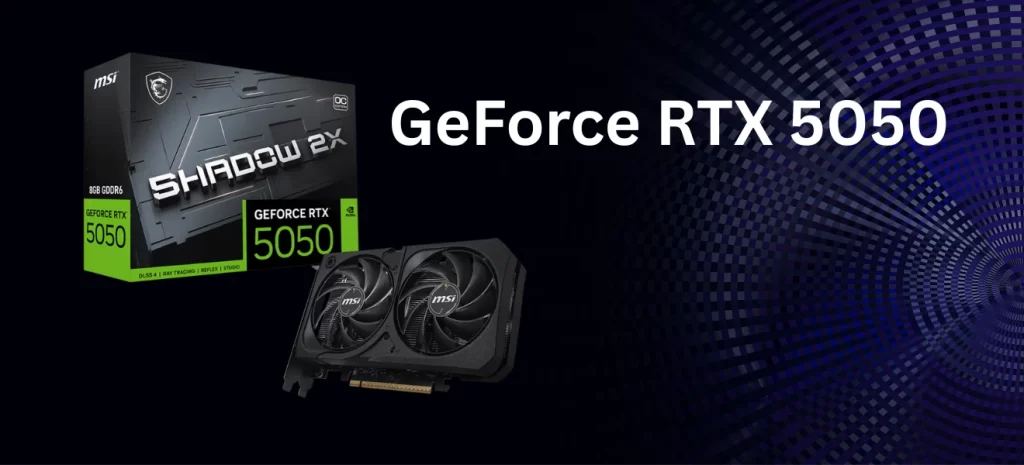When NVIDIA introduced the latest graphics cards GeForce RTX 5050, fans were looking forward to a small, economical, and affordable card that fits in even the smallest of cases. It was all the more surprising when the first models resembled monsters rather than power-saving solutions. Huge, noisy, and with cooling that would have been able to handle much more powerful cards.
Small power consumption, big body
The GeForce RTX 5050 is the most affordable member of the RTX 50 series. It offers performance comparable to the slower RTX 4060 and handles games smoothly in Full HD even at higher settings. One of the biggest draws is the low power consumption at just 130W, which suggested that a simple heatsink would suffice and fit into a compact case.
Reality, however, was disappointing at first. On the social network X, Andreas Schilling of Hardware Luxx posted photos of the first GeForce RTX 5050 and they were too big. The base models took up two slots and had two fans. Some, like the Asus Prime, even got three fans and a massive heatsink, as if it were a high-end graphics card.
So who has the biggest one?
Manufacturers have probably been jockeying for a while to see who can build the bigger card, as some of the dimensions are really exaggerated.
The Colorful iGame RTX 5050 Ultra W OC 8 GB reaches a whopping 300.5 mm (almost 12 inches) but this card is mainly of interest because of its looks.
The GIGABYTE GeForce RTX 5050 GAMING RTX 5050 OC 8G is a bit more modest, but still measures a respectable 280 mm in length (11 inches).
Gigabyte also offered the most compact bit with the first RTX 5050 models and the GeForce RTX 5050 OC Low Profile 8G, which still has three fans but is only 182 mm (7.17 inches) long.
So why are they so huge?
The answer is simple – economics and marketing. Manufacturers used off-the-shelf heatsinks from more powerful cards to save on development, and the large size made it look sturdy and premium to customers. In reality, the performance of these models was only slightly overclocked and far from deserving such massive bodies and cooling.
Fortunately, smaller RTX 5050 pieces also came
Fortunately, the market did pick up after a few weeks and manufacturers thankfully introduced much smaller and more practical versions of the GeForce RTX 5050. These already make sense for small PCs, HTPCs and gamers who don’t want an unnecessarily large box.
PNY GeForce RTX 5050 Single-Fan 8 Gb
The shortest RTX 5050 you’ll find today measures just over 146.7mm (5.78 inches) . It has a compact dual-slot design with a single fan and will fit great in even the smallest of enclosures.
INNO3D GeForce RTX 5050 COMPACT 8 Gb
Almost as small as the PNY, with a length of 148 mm (5.83 inches) . It also features a dual-slot design and a single silent fan, making it unobtrusive and sleek.
Gigabyte GeForce RTX 5050 OC Low Profile 8G
A bit longer (182 mm-7.17 inches), but still very compact. It has a low-profile design and three small fans, so it fits easily into narrow and slim cabinets
These new models have finally shown that the GeForce RTX 5050 can get by with minimalistic cooling and doesn’t need huge bodies. Thus, the manufacturers have answered the call of gamers for more reasonable solutions.
What performance is hidden in the GeForce RTX 5050?
Although the GeForce RTX 5050 looks modest, inside it has a brand new GB207-300 chip from the Blackwell family. This offers 2,560 CUDA cores, 80 Tensor cores (5th generation) and 20 RT cores (4th generation), the same technologies as the more expensive models. With a base clock speed of approximately 2,317 MHz and up to 2,572 MHz in boost, it has enough performance for modern Full HD gaming. It has 8 GB of GDDR6 memory with a throughput of 320 GB/s, connected via a 128-bit bus.
The card’s power consumption is only 130W, so it can get by with a weaker power supply and undemanding cooling. The GeForce RTX 5050 supports DLSS 4, 4th generation ray tracing, Reflex and PCIe 5.0, so you’re not missing anything important even in a cheap build. For more detailed information on the chip, visit the official Nvidia RTX 5050 website .
Conclusion
The GeForce RTX 5050 started its journey as a card wrapped in huge bodies that acted more like marketing theater than a practical solution. Fortunately, however, manufacturers were quick to respond and offer more sensible and smaller versions as well.
If you’re all about looks, quieter operation and the impression of ruggedness, a large card will serve you just as well and fill the empty space in a large cabinet. However, if you’re building a small PC or don’t want to take up space unnecessarily, reach for a PNY Single-Fan, Inno3D Compact or Gigabyte Low-Profile. In both cases, you get the same performance, so it’s up to you whether you prefer efficiency and compactness or flashy design.
The prices are almost the same, the differences are only minimal. Therefore, when choosing, be guided by where you plan to fit the card and what style suits you, rather than the price tag itself.

